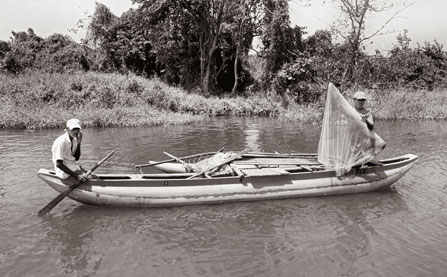Use of wetlands in flood control
Dr Meththika Vithanage
‘Wetlands are areas of marsh, fern, peat land or water whether
natural or temporary with water that is static, flowing, fresh, brackish
or salt including areas of marine water, the depth of which at low tides
does not exceed six meters’. This is the definition given by Ramsar
Convention for Wetlands which was held in 1971 in Iran. Some wetlands
are confined to freshwater and some are confined to saltwater.
|

Muturajawela wetlands, a tourist attraction. Picture by
Dushmantha Mayadunna |
Several wetlands are inundated by water for a few months of the year.
A few wetlands are made by human beings. Therefore, wetlands are
classified as freshwater wetlands, saltwater wetlands and anthropogenic
wetlands although there are overlaps in this classification. Sri Lanka
consists of several different types of wetlands.
Wetlands are typically associated with rivers and streams. Most of
the streams are located in the Central, Western and Southern part of the
country.
There are around 103 rivers in Sri Lanka; most of them are seasonal
and others are perennial. Although Sri Lanka does not have natural lakes
there are several flood plain lakes. These are called Villu and are
mainly confined to the cut-off river bends. Freshwater marshes are
another type of freshwater wetlands. They are associated with rivers;
fill up with surface runoff, river floodwater and also groundwater
seepage. Wathurana swamp forest and Muthurajawela are examples of
freshwater marshes. These are characterized by partially decomposed
organic material.
Deltas, estuaries, mangroves, lagoons and marine wetlands are
considered as saltwater wetlands. Since the velocity of flowing water in
rivers and streams is reduced when they come close to the sea, they
often divide into branches resulting deltas. Finer sediments are
deposited and form mudflats. Lagoons, estuaries and mangroves are
brackish water bodies.
Tanks, reservoirs, saltpans and agricultural wetlands are classified
under anthropogenic wetlands. All different types of wetlands are
considered as factories since they provide several necessities for human
beings.
Coastal erosion
Water, food, medicine, energy, flood control, retention of sediments,
prevention of coastal erosion and purification of water by removing
heavy metals, are few of the benefits that we get from wetlands.
Wetlands are very sensitive environments and therefore they should not
be merely abandoned but properly managed like other areas. In the past,
wetlands were considered as wastelands and obstructed in many ways. Many
were drained to be replaced by farmlands, settlements, infrastructure
and waste dumping sites.
Urbanized areas
Recent flooding in the South Western part of the country has
demonstrated the value of wetlands adjacent to streams and rivers in
heavily urbanized areas. Such areas flood because of encroachment into
the flood passage and the lack of sufficient storage to temporarily
absorb floodwaters during storms.
Rapid urbanization and the associated land use changes in the country
has encroached upon or destroyed important wetlands adjacent to rivers
and streams. Properly maintained wetlands provide flood control benefits
in many ways. First, they act as a hydrologic sponge to absorb excess
floodwaters during major storm events which are subsequently released
slowly in terms of both surface water and groundwater.
This essentially protects the downstream areas from excessive
flooding by reducing the flood peaks and water levels. It has been
estimated that only 15 percent of a watershed in wetlands can reduce
flood peaks by as much as 60 percent.
Wetlands also help slow down the floodwaters reducing soil erosion
along streams and rivers. Wetlands hold surface water, providing water
storage and shoreline stabilization. Different wetlands have different
storage capacities, depending upon their size, depth, frictional
resistance, shoreline shape and position within a watershed.
Shoreline stabilization refers to the stabilization of soil and
vegetation along bodies of water. It reduces sediments being carried
into streams and lakes, which is harmful to both the land being degraded
and the ecosystems in these waters.
They act as sediment traps and with the detention of floodwaters in
the wetland over several days they act as a kidney to remove the
pollutants often associated with floodwater during storms.
This will have significant benefit to the quality of water flowing
into rivers and streams downstream.
The slowed water also builds up the soil forming higher, more
insulated ground where terrestrial grasses and other vegetation will
grow reducing the erosive power even more.
Environmental degradation
Coastal wetlands are extremely important for protection of inlands
from severe storms or tsunamis. It has been suggested that for every
mile of vegetative wetlands storm height can be reduced by one foot.
Policy and decision makers often lack awareness of the
interconnection between the valuable ecosystems and people’s livelihoods
or between environmental degradation and poverty. As a result, wetlands
are inadequately managed leading to the destruction of its environmental
services and products.
Wetlands are an important part of our ecosystem. Our economic
well-being and quality of life largely depend on our natural resources
and wetlands are the vital link between our land and water resources. We
have already lost many of our wetlands.
We must take action to protect wetlands to ensure that the functions
and related values they provide will be preserved for present and future
generations.
The writer is a
Research Fellow at the Institute of Fundamental Studies, Kandy
|



